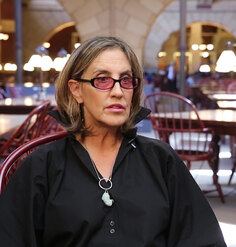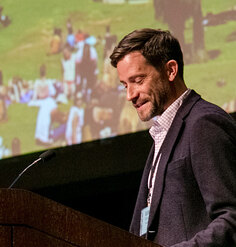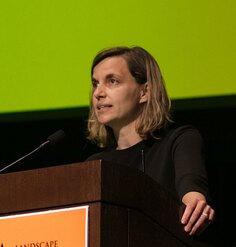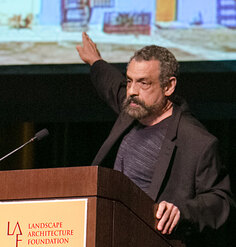On the Future of Landscape Architecture
By Carl Steinitz
This presentation was part of the Landscape Architecture Foundation’s The New Landscape Declaration: A Summit on Landscape Architecture and the Future held in Philadelphia on June 10-11, 2016. LAF asked a diverse group of leading minds to write a “Declaration” reflecting on the last half century and offering bold ideas for how landscape architecture can make its vital contribution in response to the challenges of our time.
Carl Steinitz
Professor, Harvard Graduate School of Design
Cambridge, Massachusetts
Carl Steinitz, Ph.D., is Alexander and Victoria Wiley Professor of Landscape Architecture and Planning Emeritus at Harvard Graduate School of Design, and honorary professor at the Centre for Advanced Spatial Analysis, University College London.
* Affiliation at the time of the Summit
On the Future of Landscape Architecture
by Carl Steinitz
Size and scale matter. Landscape architects have always worked across a broad range of project sizes and scales from a small garden or a house on a difficult site, to a typical midrange of new residential areas or large parks, to regional urbanization studies or conservation strategies. The reality is, however, that most landscape architects work on smaller projects.
This has not always been the case. In the nineteenth century, gardeners made gardens and architects designed buildings, developments, and even parks. Engineers designed infrastructure for expanding towns, parks, and water supply projects. There was opportunity for those with appropriate skills to work across size and scale. The landscape-oriented professions began to coalesce around the term landscape architecture. Frederick Law Olmsted, Peter Joseph Lenné, John Claudius Loudon, and Warren Manning all worked across size and scale. They all designed villas and gardens. Olmsted designed a rose garden and oversaw a forest management plan for the largest private estate in America. Lenné made designs for Potsdam and Berlin. Loudon made a plan for the London region. Manning designed both gardens and the entire United States as published in Landscape Architecture Magazine in 1923.
I see the profession mainly, but not only, from an academic perspective. The Department of Landscape Architecture in the Harvard Graduate School of Design (GSD) was founded in 1900, aided by the Olmsted office. From its earliest days, Harvard’s landscape architecture faculty taught across a wide range of scales. However, it rarely emphasized each scale equally. There has always been competition within the GSD and the larger university for academic turf. This has implications for size and scale.
By the 1920s, commissions came from the wealthy needing help in designing their villas and gardens, and professional education began to shift toward smaller projects. This loss of interest in the larger landscape and the increasing (and, in my opinion, artificial and harmful) separation of design from planning caused a political division within Harvard’s Department of Landscape Architecture, resulting in the creation of America’s first Department of City and Regional Planning. Both departments continued to emphasize physical design as taught in studios.
In 1966, when I first joined the Harvard faculty, Charles Harris and Hideo Sasaki led an attempt to bridge the gap between landscape architecture and planning. My first teaching assignment was in a collaborative studio with Charles Harris and Reginald Isaacs, with Charles Eliot II, Phil Lewis, and Ian McHarg as visitors. This kind of collaboration continued well into the 1970s.
In the late 1970s, the planning department moved away from physical design and focused on economic analysis and social planning. It subsequently moved to the Kennedy School of Government. (Planning with an emphasis on design was reestablished at the GSD in the 1990s.) Landscape architecture focused mainly on small and midsize project design. An exception was much of my own work, extending across scales but emphasizing change in the larger landscape.
In the 1990s, the GSD made a revolutionary decision. Any advanced student could take any of approximately 15 optional studios offered each semester across the whole GSD: architecture, landscape architecture, planning, and urban design. This encouraged some studios (mine included) to address a wider range of scales. At the same time, architects were becoming increasingly interested in parks and gardens, partly because of the success of the Barcelona world’s fair. Our architecture department began to offer studio projects similar to ones that had traditionally had been offered in landscape architecture.
Today, most landscape architects spend most of their professional energy working on relatively small projects. A few extend their work to include large projects. Very few work professionally at a regional scale.
Given this background, I will now try to answer the Landscape Architecture Foundation’s (LAF) question about the future of landscape architecture. I think that whatever we declare, in a generation or less, things will be different. I do not believe that just because you can design at one size and scale you can design at all sizes and scales. Methods and skills over a range of scales in landscape architecture are related but different.
I think that there are four reasonable prospective possibilities.
The first possibility is simply a continuation of what we are doing today (or trying to in a changing world).
The second acknowledges competition for what has become hot property: the landscape. Architects may increasingly design landscapes as part of their architecture; urban designers may increasingly design landscapes at mid-scale; geographers, engineers, and ecologists (and politicians, bankers, and lawyers) may increasingly make design decisions for the larger landscape. These trends will impinge on education and practice in landscape architecture. External competition will likely produce a narrower landscape architecture profession.
The third possibility is perhaps the most probable and the most wrongheaded. The artificial division between planning and design will likely continue and even be reinforced, and landscape architecture will itself choose to focus on designing smaller projects. This may result from competition from professions that consider large issues such as food and water supply, biodiversity, cultural heritage, population, and climate change as shapers of landscape. Mainly, however, it will result from two factors: society’s unfortunate but common caricature of landscape architecture as closely related to gardening and the landscape architecture profession’s own professional and academic choices.
The fourth possibility relies on embracing the wisdom of the founders of the profession. First, we must know something that other professions do not. We must be rooted in the landscape itself and at all sizes and scales: in climate, geology, hydrology, ecology, vegetation, history, perception, et cetera. Second, we must understand that almost everything we do requires collaboration with other professions and with decision makers. This was the vision of my department when I joined the faculty. It is a perspective I hold to this day.
We cannot argue that we are the sole bearers of wisdom as it pertains to the landscape, and we cannot argue that we have some self-defined right to be its stewards to be in charge, or even to coordinate design for change. Sometimes we will lead, and sometimes we will not. But if we are to work on society's most important needs, both specialist knowledge and skills of collaboration in designing are essential. We must not allow the profession to become limited in the scale and scope of its competence.











